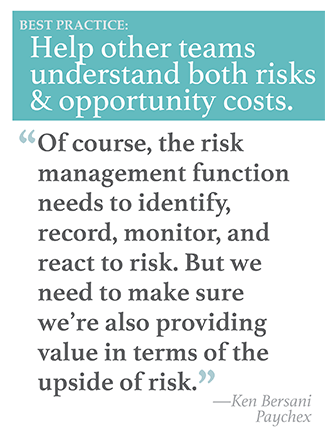
Nearly 50 years ago, Paychex was launched as a provider of outsourced payroll services to small and midsize businesses in Rochester, N.Y. Since then, the company has expanded dramatically. Today, its 14,000-plus employees serve more than 8 percent of all private-sector workers in the United States. The company's menu of services and solutions has also grown. Now clients can outsource most HR activities to Paychex, from hiring and employee on-boarding to time-keeping, retirement services, and insurance services. A robust software platform enables Paychex to make most of these offerings available via self-service online portals.
Still, payroll processing remains core to the business. And the Paychex risk management team recently uncovered a missed revenue opportunity in a crucial payroll-related process. Extreme risk aversion among operational decision-makers was eliminating a significant amount of interest income on clients' tax payments.
"In addition to sending out payroll checks, we offer a payroll tax administration service that entails filing and paying taxes on behalf of our clients," explains Ken Bersani, operating risk manager with Paychex. "We file with the IRS, with the Social Security Administration, and with various state agencies."
The appropriate cadence of these filings depends on characteristics specific to the client. For example, for small to midsize businesses, the IRS typically requires federal income tax withheld from paychecks to be paid on either a monthly or a semi-weekly basis. Businesses are expected to know which cadence is appropriate for their circumstances. Whether they file monthly or semi-weekly makes a big difference in the timing of their tax payments.
"With a semi-weekly filing frequency, a company might have to pay the IRS twice a week," Bersani says. "A company that runs payroll on Tuesday will owe the tax by Friday. In contrast, a company with a monthly filing frequency doesn't owe the IRS until the 15th of the following month. So tax withheld from a payroll run in early November isn't due until December 15."
For Paychex, which withholds tax funds from clients' payroll runs, paying taxes on December 15 for a November 5 paycheck represents five weeks of additional float, compared with paying those same taxes on November 8. However, Bersani's team discovered that the company was using semi-weekly as the default filing cadence for most incoming clients. The approach made sense from a customer service perspective.
 "If a company files monthly when it should be filing semi-weekly, it will receive a discrepancy notice from the IRS and may owe penalties," Bersani says. "No one wants to receive that mail. In an effort to better service our clients—to ensure there is no possibility they will ever receive a discrepancy notice—we began assigning a semi-weekly filing frequency to almost every client. This avoided any chance of risk and ensured we were always paying at the most frequent rate possible."
"If a company files monthly when it should be filing semi-weekly, it will receive a discrepancy notice from the IRS and may owe penalties," Bersani says. "No one wants to receive that mail. In an effort to better service our clients—to ensure there is no possibility they will ever receive a discrepancy notice—we began assigning a semi-weekly filing frequency to almost every client. This avoided any chance of risk and ensured we were always paying at the most frequent rate possible."
The risk management team immediately saw this approach's downside for corporate cash flow. They also understood that change would require a concerted education effort. "Shifting a client from the default frequency of semi-weekly filing to monthly filing was going to introduce a small possibility that the client might have to pay a penalty in the future," Bersani says. "We were proposing introducing some risk of an event that could potentially damage a client relationship. Gaining buy-in from sales and field operations was going to require quite a bit of data and communication."
The risk management team researched options and developed a methodology and algorithm that they were confident would effectively identify clients that qualified for a monthly filing cadence. As a proof of concept, they selected a subset of long-term Paychex clients. "For this initial group, we had internal information spanning the entire look-back period the IRS uses to determine correct filing frequency," Bersani says. "We ran them through our new process, and the algorithm indicated that 25 percent of our semi-weekly filers had the potential to move to a monthly frequency."
Next they calculated the lost interest that the company was missing out on by filing far too frequently for those customers. "We determined exactly how cash flow would be affected if we translated some of those lowest-risk clients to a monthly frequency to yield more favorable float results," Bersani says. The numbers were significant enough to convince corporate leadership to accept the modest risks Bersani's team was proposing.
After transitioning that initial group of clients to monthly filing, the risk management team began running the algorithm on clients for which Paychex had less internal information. As they slowly added more clients to the monthly cadence, the algorithm proved to be 99.99 percent accurate in identifying the appropriate filing frequency for each company, according to Bersani.
See also:
In fact, it has proven so successful that Paychex has begun extending this process to some state taxes, as well. "Unfortunately, each state has its own rules and calculations," Bersani says. "We can use the IRS algorithm as a basis, but then we have to recode and reclassify the risk factors for the individual state because it might make determinations much differently than the IRS does."
Bersani sees this project as the perfect demonstration that risk aversion carries opportunity costs—a fact that may not be obvious to people outside the finance and risk management functions. "We highlighted that our prior approach, which was perceived internally as being extraordinarily helpful to our clients, was actually having a serious negative impact to the bottom line," he says. "We helped people understand that they need to look at all the different risk factors and potential fallout of their activities.
"As a result," Bersani adds, "we're seeing more and more requests coming into our risk team where other groups within the company are asking, 'Hey, we're thinking about making this change to our business. What do you think that will do to X, Y, and Z?' Because of the demonstrated success of this project, business units throughout Paychex are now looking to us as essential partners to validate changes and help them find new opportunities in terms of both revenue and process improvements."
What can other risk management teams learn from the Paychex experience? "Of course, the risk management function needs to identify, record, monitor, and react to risk," Bersani says. "But we need to make sure we're also providing value in terms of the upside of risk. We need to help other parts of the organization become more sophisticated in their risk management."
© Touchpoint Markets, All Rights Reserved. Request academic re-use from www.copyright.com. All other uses, submit a request to [email protected]. For more inforrmation visit Asset & Logo Licensing.



